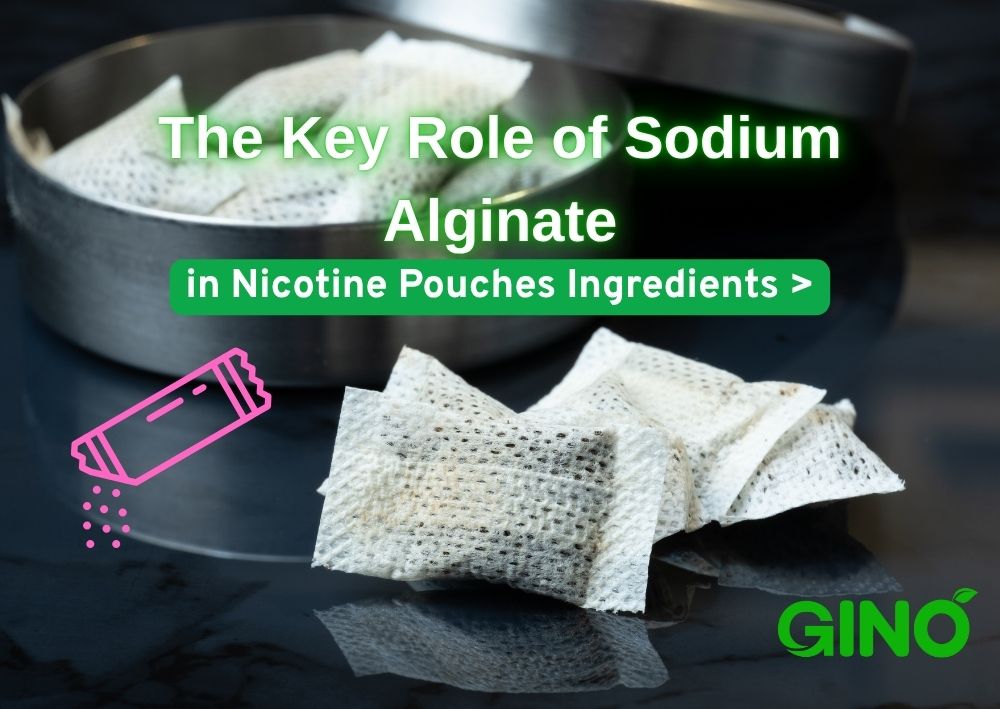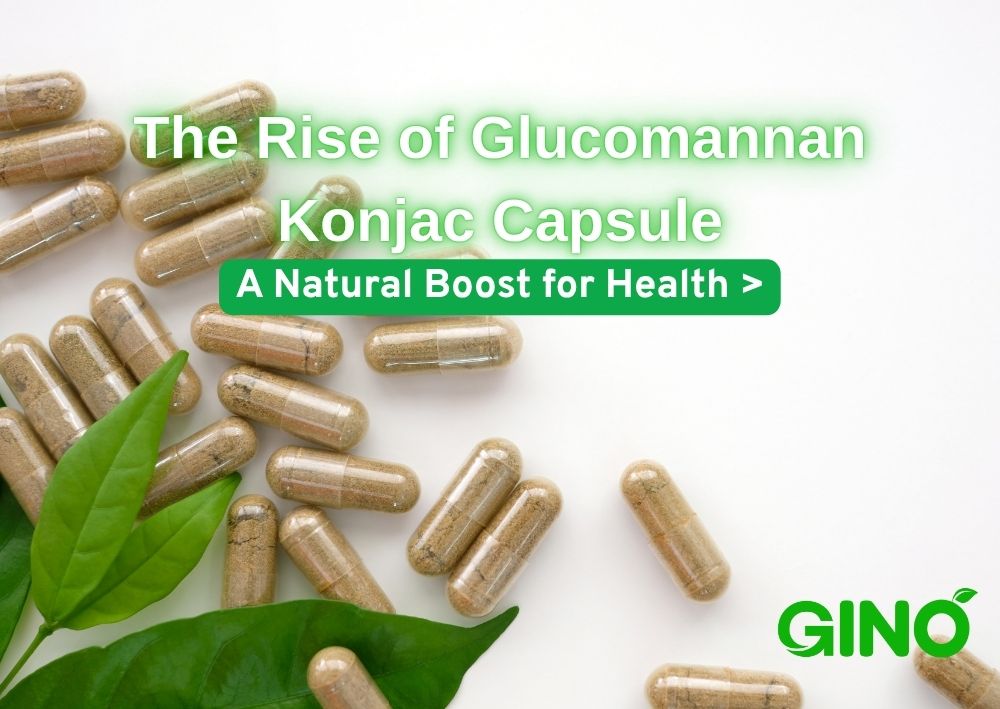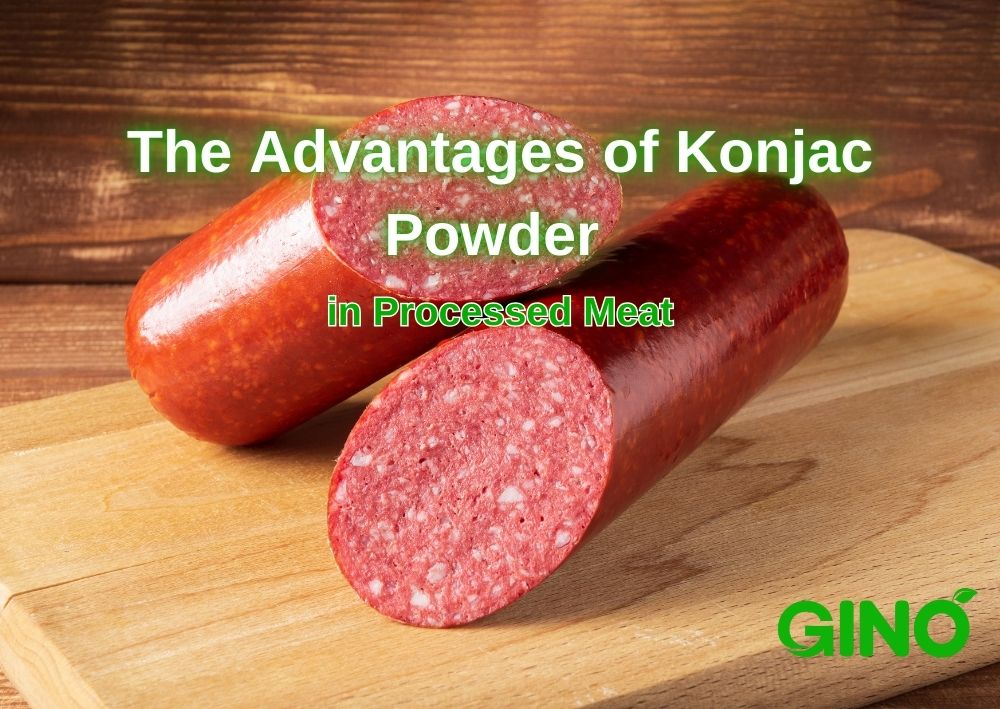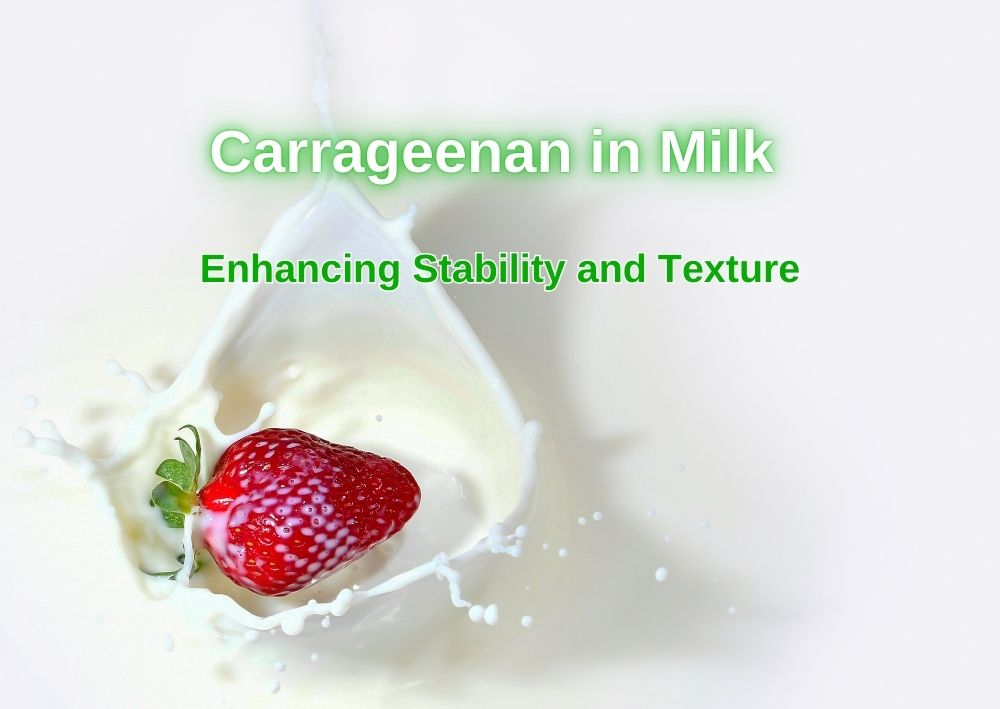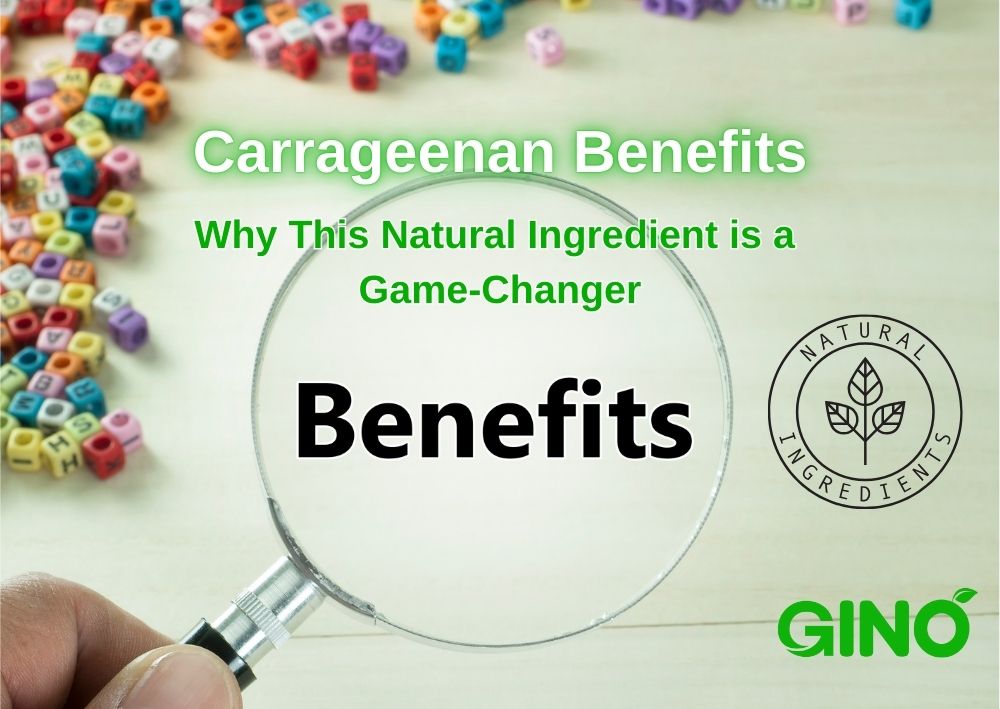
What is Sodium Alginate?
What is Sodium Alginate
Abstract:
What is sodium alginate? As a thickening and stabilizing agent for food and other industries, sodium alginate has unique functions and advantages.
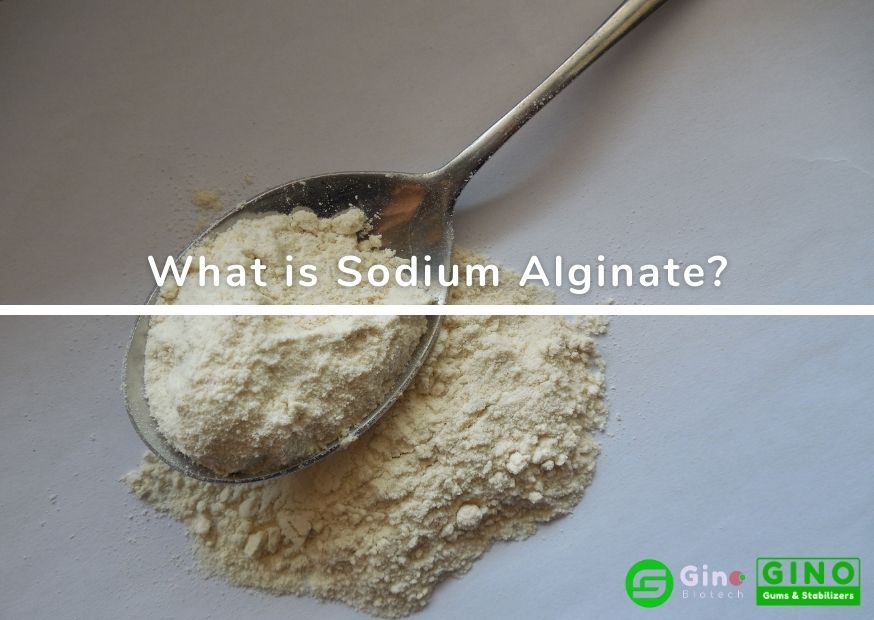
What is Sodium Alginate?
Sodium alginate is a natural polysaccharide with the stability, solubility, viscosity, and safety required as an excipient for pharmaceutical preparations. In 1881, the alginate extract from brown seaweed was first studied scientifically by the English chemist E.C. Stanford, who found that the extract of this fucoidan had several very interesting properties, it had the ability to concentrate solutions, form gel and film-forming ability, based on which he made several applications for industrial production.
However, large-scale industrial production of sodium alginate did not take place until 50 years later. Commercial production began in 1927, and the alginate market is projected to cross USD 755 million by 2027, according to a new research report by Global Market Insights Inc. 30% of which The alginate market is projected to cross USD 755 million by 2027, according to a new research report by Global Market Insights Inc.
1. Composition of Sodium Alginate
- What is sodium alginate made of?
Sodium alginate consists mainly of the sodium salt of alginate, a copolymer of β-D-mannuronic acid (M-unit) and α-L-gulonuronic acid (G-unit) linked by β-1,4-glycosidic bonds and composed of different proportions of GM, MM and GG fragments.
2. Molecular Weight of Sodium Alginate

The molecular weight of commercial sodium alginate is usually dispersed like polysaccharides. Therefore, the molecular weight of sodium alginate usually represents the average of all molecules in the group. The most common ways of expressing molecular weight are the number-average molecular weight (Mn) and the heavy-average molecular weight (Mw). In polydisperse molecular groups, usually Mw>Mn.
The coefficient of Mw/Mn is the dispersibility index, and the classical range of the index for sodium alginate commodities is 1.5 to 2.5. The most common method for determining molecular weight is calculated based on internal viscosity and light scattering measurements.
The molecular formula of sodium alginate is (C6H7NaO6)x.
3. Production Process of Sodium Alginate
What is sodium alginate manufacturing process? What is sodium alginate made of? The process flow of sodium alginate is as follows.
- Crushing dry or wet seaweed (algae), washing and removing impurities, extracting with strong alkaline water and clarifying to get crude alginate solution.
- The colored calcium alginate is obtained by calcium chloride precipitation.
- Decolorization, de-odorization and then treated with acid to remove soluble impurities, you can get alginate precipitation, and get sodium alginate by the action of sodium carbonate
- Then dried, crushed and sieved to obtain sodium alginate powder.
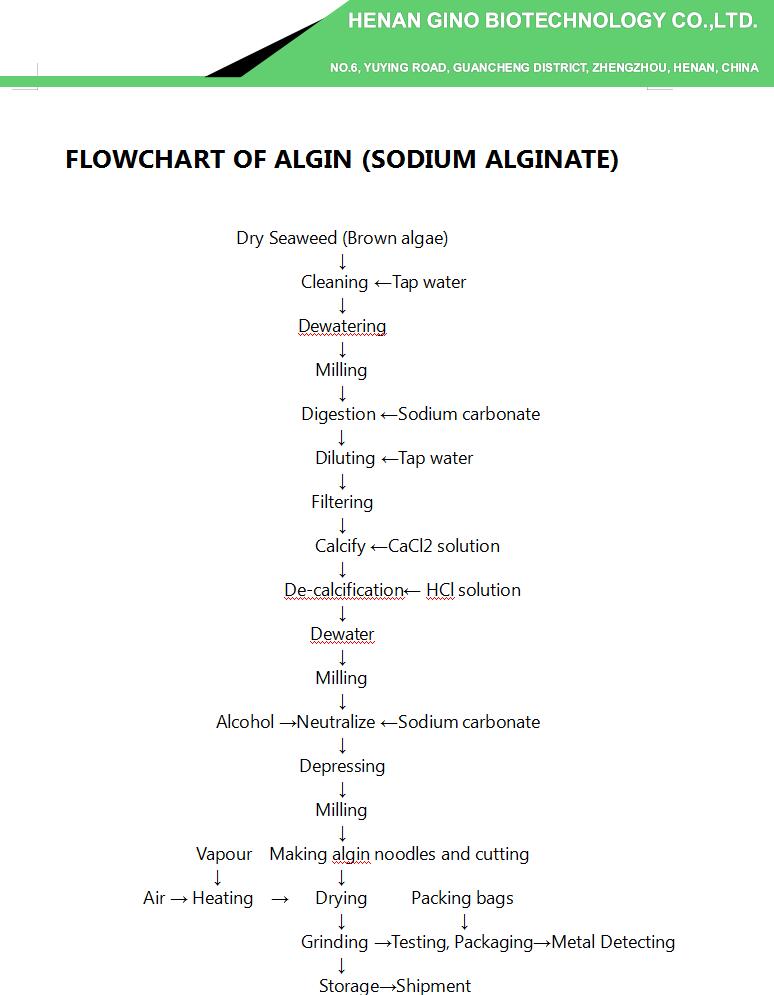
4. Properties of Sodium Alginate
4.1 The characteristics of sodium alginate
Sodium alginate is a polymer of β-anhydrous sodium dextro-mannurate, white or light yellow powder, almost odorless and tasteless. Sodium alginate is soluble in water and insoluble in ethanol, ether, chloroform, and other organic solvents. It dissolves in water and becomes a viscous liquid. The pH value of 1% aqueous solution is 6-8.
The viscosity is stable when pH=6-9, and decreases when heated to above 80 ℃. Sodium alginate is non-toxic, LD50>5000mg/kg. What is the effect of the chelating agent on the properties of sodium alginate solution? The chelating agent can complex the divalent ions in the system so that sodium alginate can be stabilized in the system.
4.2 pH value of sodium alginate
What is sodium alginate's solubility? Sodium alginate is slightly soluble in water and insoluble in most organic solvents. It dissolves in an alkaline solution, which makes the solution viscous.
Sodium alginate powder becomes wet when it meets water, and the hydration of particles makes its surface sticky. Then the particles quickly bond together to form agglomerates, which are very slowly and completely hydrated and dissolved.
If the water contains other compounds that compete with alginate for hydration, sodium alginate is more difficult to dissolve in water. The presence of sugar, starch, or protein in the water will reduce the rate of hydration of sodium alginate and longer mixing times are necessary. Salts of monovalent cations (e.g. NaCl) have a similar effect at concentrations above 0.5%. The pH of sodium alginate in a 1% solution of distilled water is about 7.2.
4.3 Stability of sodium alginate
Sodium alginate is hygroscopic and the amount of moisture contained at equilibrium depends on the relative humidity.
Dried sodium alginate is quite stable when stored in well-sealed containers at 25°C and below. Sodium alginate solution is stable at pH 5 to 9. The degree of polymerization (DP) and molecular weight are directly related to the viscosity of sodium alginate solution, and the decrease in viscosity during storage can be used to estimate the degree of sodium alginate depolymerization. Sodium alginate with high degree of polymerization is less stable than sodium alginate with low degree of polymerization.
Sodium alginate is reported to undergo proton-catalyzed hydrolysis, which depends on time, pH and temperature. Propylene glycol alginate solutions are stable at room temperature, pH 3 to 4; pH less than 2 or greater than 6, the viscosity decreases quickly even at room temperature.
Jump To Section
5. The Function of Sodium Alginate - Thickening and film formation
- What is sodium alginate used for?
5.1 As a stabilizer for ice cream and other cold drinks, sodium alginate is a high-grade stabilizer
Sodium alginate in ice cream can make ice cream and other cold drinks produce a smooth appearance and silky texture.
Since calcium alginate can form a stable thermally irreversible gel, thus it will not become rough (ice crystal growth) during transportation and storage, and no ice cream deformation due to temperature fluctuation will occur; meanwhile this ice cream is odorless when consumed, improves both expansion rate and melting point, making the quality and benefit of the product significantly improved. The product is smooth, delicate, and has good taste.
What is the sodium alginate dosage in ice cream? The addition amount is low, generally 1-3‰, and 5-10‰ in foreign countries. Used as a stabilizer for dairy products and beverages, frozen cow's milk stabilized by sodium alginate has good taste, no stickiness, stiffness, sticky and sluggish when stirring.
5.2 It is mainly used as suspension aid, emulsifier, viscous agent and capsule material of microcapsules in pharmaceuticals
Sodium alginate has been listed as a safe food additive without restriction in Europe, America, and Japan.
As a kind of seaweed gum, it can improve the nature and structure of food with its inherent physical and chemical properties, it is low heat and non-toxic, easy to expand, has high flexibility, and is added to food whose functions are coagulation, thickening, emulsification, suspension, stabilization and prevention of food drying.
And the main function is gelation, that is, the formation of edible gel, nearly solid, to maintain the shape of the molding. Thus, it is an excellent food thickener additive. It can not only increase the nutritional composition of food, improve product quality and increase the variety of colors, but also reduce the cost and improve the economic efficiency of enterprises.
6.Application of Sodium Alginate in Food
- What is sodium alginate used in food?

6.1 Application of sodium alginate in bakery & flour foods
Adding 0.2%-0.5% sodium alginate in the production of fish noodles, fast food noodles can significantly increase the stickiness, prevent brittleness, effectively reduce the rate of breakage, resistant to cooking, soaking, non-sticky strips, strong tendon, high toughness, delicate, lubricious and chewy taste.
In the production of bread and other pasta and cakes, adding 0.1%-1% sodium alginate can prominently prevent aging and drying, reduce falling crumbs, and eat with tenderness and good taste.
6.2 Application of sodium alginate in ice-cream, popsicle and ice-cream
When producing ice cream, popsicles, and ice cream, 0.1%-0.5% sodium alginate is added as a stabilizer, which makes the mixture even, easy to adjust the flow of the mixture when it is frozen and easy to mix.
The products made are good conformation, smooth and delicate, good taste, and no ice crystals are formed during storage, but also stabilize the air bubbles in it, and the expansion rate of the product is increased by about 18%. Increase the yield by 15%-17%, while making the product fluffy and elastic.
6.3 Application of sodium alginate in milk products and beverages
Sodium alginate can be used as a stabilizer for frozen milk, frozen juice, and other beverages. Adding an appropriate amount of sodium alginate to frozen milk can obviously increase the taste, without a sticky and stiff feeling.
Especially, adding 0.25%-2% sodium alginate to yogurt can maintain and improve its curd shape and prevent viscosity drop during high-temperature sterilization, and also prolong the storage period so that its special flavor remains unchanged. It can also be used as a margarine thickening and emulsifier.
Besides, it is added to beverages and made into a crisp and fruity syrup with saccharin and auxiliary ingredients, which has a smooth and even taste and is stable without stratification.
6.4 Application of sodium alginate in the production of candy, frozen sweets and food fillings
Using sodium alginate as the main additive, it can produce top-quality soft candy, fresh jelly, grape beads, lotus seed soup, fungus soup, adzuki bean soup, and so on. It can also be prepared with other auxiliary ingredients in a certain ratio and frozen to obtain smooth and firm textured pudding.
In addition, with the additives of sodium alginate and starch, it can be made to replace the candy and pastry lining packaging film, which is commonly known as "glutinous rice paper", to prevent the melting of candy and pastry oil insulation, with excellent results.
Not only can improve the strength and flexibility of the film, which is conducive to mechanized production, but also can save food and reduce costs.
Adding sodium alginate to the core and filling of food obviously shows good gel performance and strong bonding power.
For example pies, moon cakes, sandwich cakes, crushed fruit sweets, bun fillings, etc., are eaten with uniform texture and good taste.
6.5 Application of sodium alginate in health food
Sodium alginate is an indispensable dietary fiber for the human body with unique nutrition, which can combine organic matter, lower cholesterol in serum and liver, inhibit the rise of total fat and total fatty acid concentration, and also improve the digestion and absorption of nutrients, as well as inhibit the absorption of radioactive strontium, cadmium and other harmful elements in the body.
Because sodium alginate is the sodium salt of carboxylic acid (containing -COONa) and can be soluble in water, and the carboxylic acid ion (COO-) with negative charge can combine with harmful heavy metal elements such as lead and mercury in human body to produce heavy metal salt precipitation of alginate. It is insoluble in water, so it can be excreted from the body with feces.
Glucose-lowering pills, sweet jellies, juice and honey powders, orange juice, etc. prepared with sodium alginate will help treat hypertension, coronary heart disease, obesity, diabetes, and diseases of the intestinal system with long-term consumption.
Health food is generally dissolved by sodium alginate in water with excipients, mixed evenly, and then cured into pellet-like, strip-like, fibrous paper-like, which can be made into a solid beverage or imitation meat food. Sodium alginate as a food additive accounts for about 10% of the total amount in Japan.
Jump To Section
7.Application of Sodium Alginate in Other Industries
7.1 Application on pharmaceutical preparation
Sodium alginate was included in the United States Pharmacopoeia as early as 1938.
Alginate was included in the British Pharmacopoeia in 1963.
Alginate is insoluble in water, but it swells when put into water.
Therefore, sodium alginate has traditionally been used as a binder for tablets and alginate as a disintegrant for immediate-release tablets.
However, the effect of sodium alginate on the properties of the tablet depends on the amount put in the prescription, and in some cases, sodium alginate can facilitate the disintegration of the tablet. Sodium alginate can be added during the granulation process rather than in powder form after granulation, making the process simpler.
The resulting tablets are mechanically stronger than those made with starch.
7.2 Sodium alginate is also used in the production of suspensions, gels and concentrated emulsions based on fats and oils
Sodium alginate is used in some liquid drugs to enhance the viscosity and improve the suspension of solids. Propylene glycol alginate improves the stability of emulsions Controlled-release drug delivery systems play an important role in health care.
The time before water-soluble drug particles are separated from the colloidal medium is minimized to ensure maximum drug loading.
However, this is not important for water-insoluble drugs. They found that drug release is related to the solubility of the drug used.
7.3 Application of Sodium Alginate in Printing and Spinning Industry
Dyeing auxiliary for reactive dyestuff
Sodium alginate is used as a reactive dyestuff color paste in the printing and dyeing industry, which is better than grain starch and other pastes. Printed textiles have bright patterns, clear lines, high color-giving capacity, uniform color, good permeability, and plasticity.
Algae gum is the best slurry for the modern printing and dyeing industry, it is now widely used in the printing of cotton, wool, silk, nylon, and other kinds of fabrics, especially suitable for preparing dial dyeing printing slurry.
7.4 Application of Sodium Alginate in Pharmaceutical Industry
PSS is a kind of sodium fucoidan disaccharide developed from alginate, which has the functions of anticoagulation, blood lipid reduction, and blood viscosity reduction.
The use of algae gum instead of rubber, and plaster for dental impression material, is not only cheap, easy to operate, and more accurate printed tooth shape. Algae gum can also be used to make various forms of hemostatic agents, including hemostatic sponge, hemostatic gauze, hemostatic film, scald gauze, spray hemostatic agent, etc.

Prospects of Sodium Alginate Uses
This article introduces the current research status of sodium alginate and prospects of sodium alginate uses in the pharmaceutical and food industries and gives an outlook on its development.

